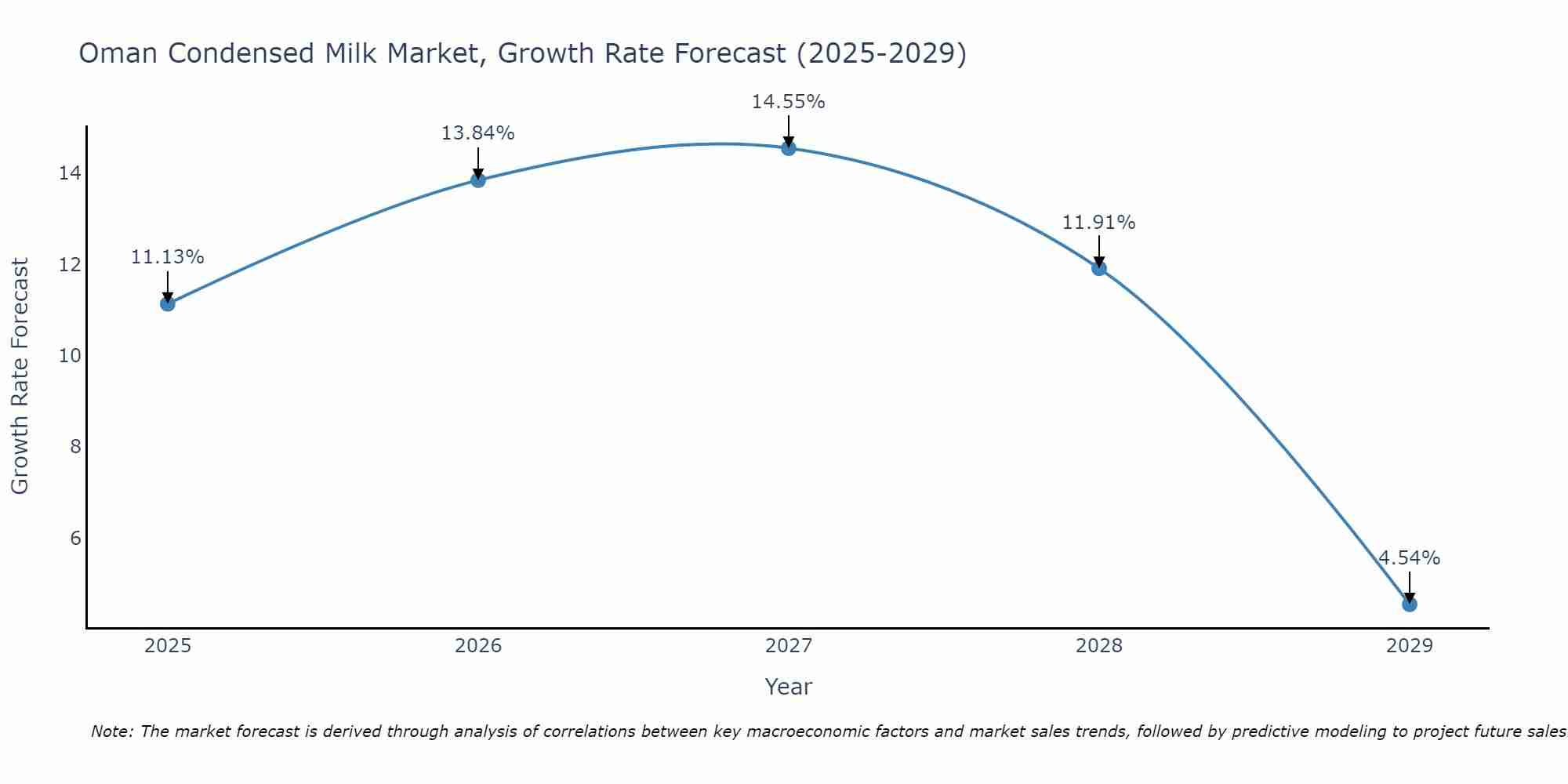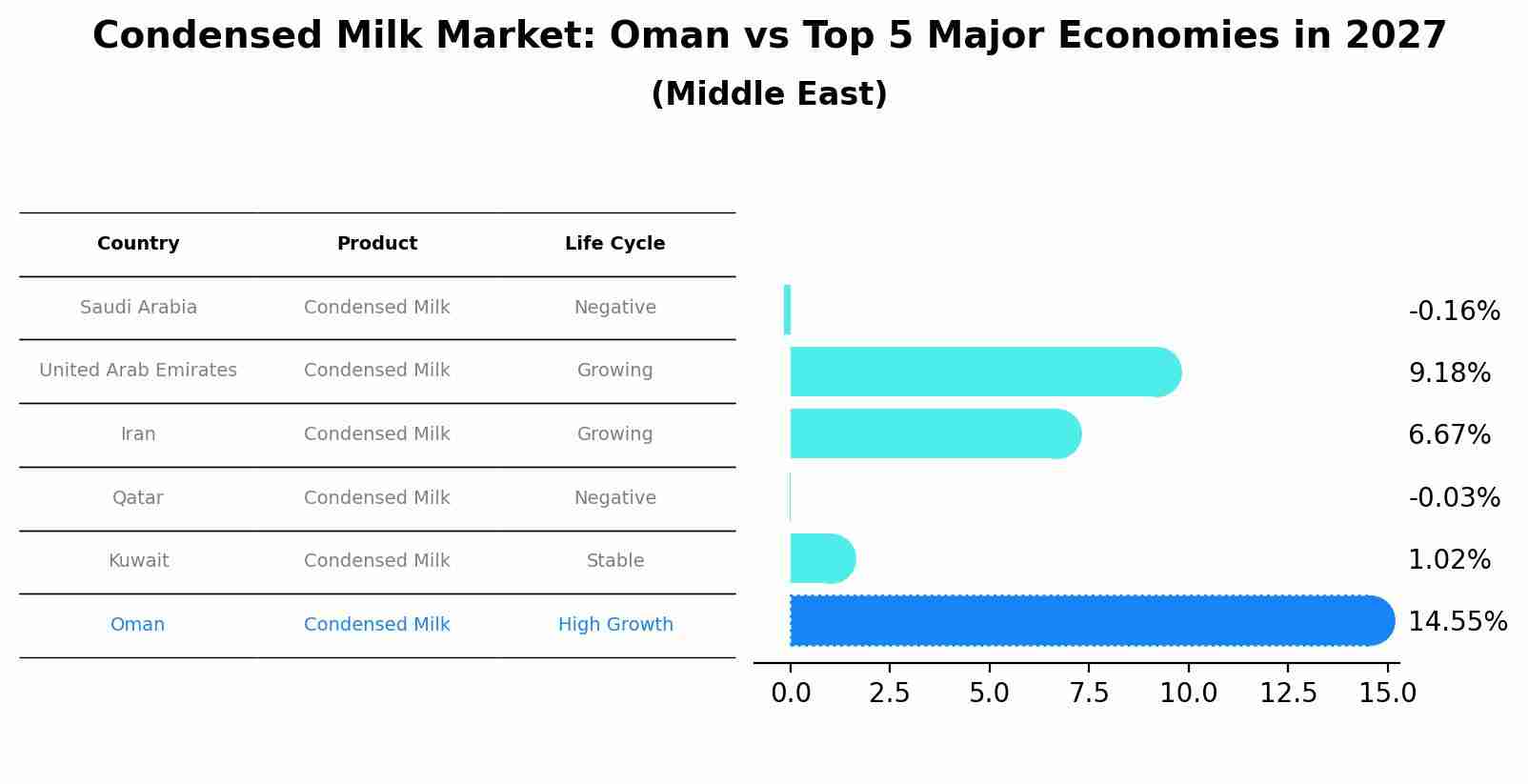Oman Condensed Milk Market (2025-2031) Outlook | Value, Companies, Share, Revenue, Trends, Growth, Industry, Forecast, Size & Analysis
| Product Code: ETC381103 | Publication Date: Aug 2022 | Updated Date: Apr 2025 | Product Type: Market Research Report | |
| Publisher: 6Wresearch | Author: Shubham Padhi | No. of Pages: 75 | No. of Figures: 35 | No. of Tables: 20 |
Oman Condensed Milk Market Size Growth Rate
The Oman Condensed Milk Market is projected to witness mixed growth rate patterns during 2025 to 2029. The growth rate begins at 11.13% in 2025, climbs to a high of 14.55% in 2027, and moderates to 4.54% by 2029.

Condensed Milk Market: Oman vs Top 5 Major Economies in 2027 (Middle East)
In the Middle East region, the Condensed Milk market in Oman is projected to expand at a high growth rate of 14.55% by 2027. The largest economy is Saudi Arabia, followed by United Arab Emirates, Iran, Qatar and Kuwait.

Oman Condensed Milk Market Overview
Condensed milk is a popular dairy product consumed in Oman as a sweetener in tea, coffee, and desserts. The condensed milk market in Oman is driven by its long shelf life, convenience, and versatility in culinary applications. As a staple in Omani households and a key ingredient in traditional recipes, condensed milk enjoys steady demand throughout the year. Manufacturers often introduce flavored and low-fat variants to cater to changing consumer preferences and dietary trends.
Drivers of the market
The Oman condensed milk market is driven by factors such as changing consumer lifestyles, urbanization, and the growing demand for convenient and nutritious dairy products. Condensed milk is widely used in various culinary applications, including desserts, beverages, and confectionery items, thereby contributing to its market growth. Moreover, product innovation, marketing strategies, and distribution channels play crucial roles in expanding market reach and consumer penetration.
Challenges of the market
The Oman condensed milk market faces challenges related to changing consumer preferences and increasing health consciousness. Condensed milk is a staple ingredient in many traditional Omani desserts and beverages. However, with the rising awareness of health issues associated with high sugar and fat content, consumers are increasingly seeking healthier alternatives. Market players need to innovate and introduce healthier variants of condensed milk to cater to evolving consumer preferences. Moreover, the market is susceptible to fluctuations in dairy prices, which can affect the overall profitability of condensed milk production. Additionally, stringent regulations and quality standards for dairy products pose challenges for ensuring compliance and maintaining market competitiveness.
Government Policy of the market
The Omani government supports the food and beverage industry through policies that encourage domestic production and reduce reliance on imports. Regulations ensure the quality and safety of food products, including condensed milk. There are also initiatives to boost local dairy production, which indirectly supports the condensed milk market by providing raw materials and encouraging local processing industries.
Key Highlights of the Report:
- Oman Condensed Milk Market Outlook
- Market Size of Oman Condensed Milk Market, 2024
- Forecast of Oman Condensed Milk Market, 2031
- Historical Data and Forecast of Oman Condensed Milk Revenues & Volume for the Period 2021-2031
- Oman Condensed Milk Market Trend Evolution
- Oman Condensed Milk Market Drivers and Challenges
- Oman Condensed Milk Price Trends
- Oman Condensed Milk Porter's Five Forces
- Oman Condensed Milk Industry Life Cycle
- Historical Data and Forecast of Oman Condensed Milk Market Revenues & Volume By Product Type for the Period 2021-2031
- Historical Data and Forecast of Oman Condensed Milk Market Revenues & Volume By Dairy for the Period 2021-2031
- Historical Data and Forecast of Oman Condensed Milk Market Revenues & Volume By Non-Dairy for the Period 2021-2031
- Historical Data and Forecast of Oman Condensed Milk Market Revenues & Volume By Packaging Type for the Period 2021-2031
- Historical Data and Forecast of Oman Condensed Milk Market Revenues & Volume By Cans for the Period 2021-2031
- Historical Data and Forecast of Oman Condensed Milk Market Revenues & Volume By Tubes for the Period 2021-2031
- Historical Data and Forecast of Oman Condensed Milk Market Revenues & Volume By Bottles for the Period 2021-2031
- Historical Data and Forecast of Oman Condensed Milk Market Revenues & Volume By Distribution Channel for the Period 2021-2031
- Historical Data and Forecast of Oman Condensed Milk Market Revenues & Volume By Supermarkets and Hypermarkets for the Period 2021-2031
- Historical Data and Forecast of Oman Condensed Milk Market Revenues & Volume By Convenience Stores for the Period 2021-2031
- Historical Data and Forecast of Oman Condensed Milk Market Revenues & Volume By Specialty Stores for the Period 2021-2031
- Historical Data and Forecast of Oman Condensed Milk Market Revenues & Volume By Online Retails for the Period 2021-2031
- Historical Data and Forecast of Oman Condensed Milk Market Revenues & Volume By Others for the Period 2021-2031
- Oman Condensed Milk Import Export Trade Statistics
- Market Opportunity Assessment By Product Type
- Market Opportunity Assessment By Packaging Type
- Market Opportunity Assessment By Distribution Channel
- Oman Condensed Milk Top Companies Market Share
- Oman Condensed Milk Competitive Benchmarking By Technical and Operational Parameters
- Oman Condensed Milk Company Profiles
- Oman Condensed Milk Key Strategic Recommendations
Frequently Asked Questions About the Market Study (FAQs):
- Single User License$ 1,995
- Department License$ 2,400
- Site License$ 3,120
- Global License$ 3,795
Search
Thought Leadership and Analyst Meet
Our Clients
Related Reports
- Afghanistan Apparel Market (2026-2032) | Growth, Outlook, Industry, Segmentation, Forecast, Size, Companies, Trends, Value, Share, Analysis & Revenue
- Canada Oil and Gas Market (2026-2032) | Share, Segmentation, Value, Industry, Trends, Forecast, Analysis, Size & Revenue, Growth, Competitive Landscape, Outlook, Companies
- Germany Breakfast Food Market (2026-2032) | Industry, Share, Growth, Size, Companies, Value, Analysis, Revenue, Trends, Forecast & Outlook
- Australia Briquette Market (2025-2031) | Growth, Size, Revenue, Forecast, Analysis, Trends, Value, Share, Industry & Companies
- Vietnam System Integrator Market (2025-2031) | Size, Companies, Analysis, Industry, Value, Forecast, Growth, Trends, Revenue & Share
- ASEAN and Thailand Brain Health Supplements Market (2025-2031) | Strategy, Consumer Insights, Analysis, Investment Trends, Opportunities, Growth, Size, Share, Industry, Revenue, Segments, Value, Segmentation, Supply, Forecast, Restraints, Outlook, Competition, Drivers, Trends, Demand, Pricing Analysis, Competitive, Strategic Insights, Companies, Challenges
- ASEAN Bearings Market (2025-2031) | Strategy, Consumer Insights, Analysis, Investment Trends, Opportunities, Growth, Size, Share, Industry, Revenue, Segments, Value, Segmentation, Supply, Forecast, Restraints, Outlook, Competition, Drivers, Trends, Demand, Pricing Analysis, Competitive, Strategic Insights, Companies, Challenges
- Europe Flooring Market (2025-2031) | Outlook, Share, Industry, Trends, Forecast, Companies, Revenue, Size, Analysis, Growth & Value
- Saudi Arabia Manlift Market (2025-2031) | Outlook, Size, Growth, Trends, Companies, Industry, Revenue, Value, Share, Forecast & Analysis
- Uganda Excavator, Crane, and Wheel Loaders Market (2025-2031) | Strategy, Consumer Insights, Analysis, Investment Trends, Opportunities, Growth, Size, Share, Industry, Revenue, Segments, Value, Segmentation, Supply, Forecast, Restraints, Outlook, Competition, Drivers, Trends, Demand, Pricing Analysis, Competitive, Strategic Insights, Companies, Challenges
Industry Events and Analyst Meet
Whitepaper
- Middle East & Africa Commercial Security Market Click here to view more.
- Middle East & Africa Fire Safety Systems & Equipment Market Click here to view more.
- GCC Drone Market Click here to view more.
- Middle East Lighting Fixture Market Click here to view more.
- GCC Physical & Perimeter Security Market Click here to view more.
6WResearch In News
- Doha a strategic location for EV manufacturing hub: IPA Qatar
- Demand for luxury TVs surging in the GCC, says Samsung
- Empowering Growth: The Thriving Journey of Bangladesh’s Cable Industry
- Demand for luxury TVs surging in the GCC, says Samsung
- Video call with a traditional healer? Once unthinkable, it’s now common in South Africa
- Intelligent Buildings To Smooth GCC’s Path To Net Zero


















